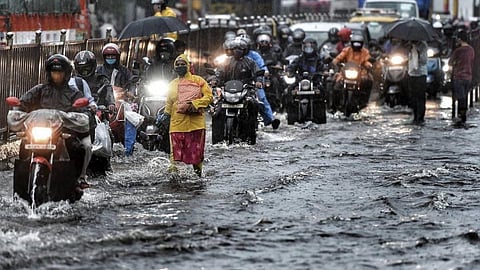
- Topics
- Feature
- Opportunities & Events
- About
- Hindi Portal
- Data
- Topics
- Feature
- Opportunities & Events
- About
- Hindi Portal
- Data

Participatory flood risk mapping is a well-recognized and widely implemented tool for meaningful community involvement in disaster risk reduction. It generally entails a process that enables the local community to physically locate on maps the impending flood risks in communities, their resources, and the countermeasures they can adopt.
Local communities are the primary victims of the event and also the first to respond when disaster strikes. Therefore, local communities’ perception of the spatial distribution of risk plays a critical role in disaster risk reduction. The participatory flood risk mapping also helps obtain information that is otherwise very difficult to extract.
The participatory flood risk mapping is also considered to be an effective tool to enhance the community’s risk awareness and preparedness intention, as it provides a visual demonstration of risks through maps.
The effectiveness of participatory flood risk mapping remains anecdotal. The claims made in favour of participatory flood risk mapping are seldom empirically tested. Moreover, participatory mapping has rarely been identically carried out in two different places by two different organizations. Hence, the same exercise has varied outcomes and success rates in different places.
This seemingly effective, widely implemented participatory disaster risk reduction tool has remained unclear about how and to what extent participatory flood risk mapping can meaningfully engage local communities in the decision-making process. This opaqueness creates an urgent need to investigate what makes the participatory flood risk mapping tool effective for community participation in disaster risk reduction.
The participatory flood risk mapping exercise has rarely been applied identically in two different places by two different organizations, which produces varied and uncertain outcomes.
This study by Samaddar et al published in the International Journal of Disaster Risk Science examines what factors and methods make participatory flood risk mapping an effective participatory disaster risk reduction tool. This study identifies the process-based criteria of participation.
A participatory flood risk mapping exercise conducted in a flood-prone informal settlement in Dharavi, Mumbai is discussed. The exercise was carefully designed to meet the process criteria of effective participation. Finally, using qualitative research methods, the effectiveness of participatory flood risk mapping is evaluated from the local community perspective.
The findings show that ensuring community livelihood security and true involvement of marginalized groups, preparing an action plan, and incorporating fun and cultural connotations into the facilitation process are critical components that enhance community participation through participatory flood risk mapping in disaster risk reduction.
Key findings and planning implications for disaster risk reduction
The study findings reiterate the importance of sufficiently integrated disaster risk management such that disaster risk is not treated alone but rather is analysed in relation to other life risks, including employment risks, financial risks, health risks, and so on. When the livelihood of local communities is interlinked with a participatory flood risk mapping exercise, communities at risk have more incentive to participate in the program. This helps to build social resiliency and to transform local communities.
Participatory flood risk mapping can guide the community to possible flood countermeasures they can adopt to reduce loss and protect livelihood.
Furthermore, the involvement of different stakeholders, such as municipal engineers and government officials, was suggested to increase the credibility of the participatory flood risk mapping process.
The full paper can be viewed here